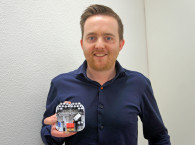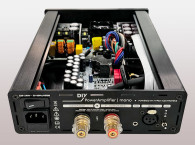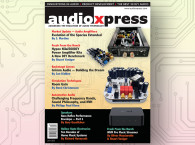
A renaissance occurred, and as is often true, it seemed to happen all in one place — northern Europe, which has been a traditional home for audio innovation. One name that keeps popping up is Bruno Putzeys who has been an integral part of Hypex, Purifi, and Kii, and originated the first practical self-oscillating Class-D amplifiers, which kick-started the rapid evolution of the genre. The various companies selling these products have been competing to see how flat, quiet, and linear they can make their amps. After having several of the top brands pass through here whose performance exceeded that of my test gear, I have been of two minds regarding further development: Does it really matter once we have comfortably exceeded any questions of audibility? On the other hand, isn’t it desirable to have absolutely the best performance that can be engineered into a product if it can be done without compromising practicality (e.g., cost, size, reliability, and efficiency)?
The Hypex NCx500 is the latest missile launched in the Power Amplifier Performance War.
“What’s the Motivation?”
Traditionally, if you wanted to go into the high-performance audio electronics business, you could start from scratch and design a circuit, design the circuit boards, the case, the power supply, and the wiring, then either build a final product or have it assembled to your specifications. In years past, designers learned to shortcut the process by building so-called chip amps (notably the various Gainclone amps), which were based on hybrid integrated circuit (IC) power amps; add heatsinking, a power supply, I/O connections, and relatively simple surrounding circuitry, drop them in a nice case, and assuming basic designer competence in layout and grounding, you could have a very good performer. It won’t be state of the art, but it will be a competent performer. And it’s not design, really, but integration, and differences in performance between integrators can still be significant.
In the wonderful modern era, one can still buy power ICs suitable for constructing chip amps, but for really serious performance goals and high power, the integrator can now opt for Class-D modules, of which there is now a very broad choice. They are somewhat larger than their IC predecessors but still quite small. And for a fair comparison, we have to look beyond the size of the amplification itself (chip vs. Class-D module). There’s a physical limitation because making a device smaller also makes it more difficult to pull heat out of it, and thermal dissipation requirements means that the actual size is chip plus support circuitry plus heatsink versus Class-D module plus its heatsink. Class D, of course, has much higher efficiencies, so the heatsinking requirements are less onerous.
Of course, size reduction has its limits. With marginal gains in efficiency at higher powers, the challenge becomes heat removal. Even with a 92% efficiency (and that’s an optimistic number), a 200W amplifier will still have to dissipate 16W, which is easy when there’s enough radiating area, but harder if the amp were, say, the size of a postage stamp. But if it’s the size of a playing card, this is certainly small enough for any practical purpose and sufficient area to be able to draw out the heat without resorting to fancy tricks. More about this in a bit.
Integrators have the option of incorporating them into power amplifiers, where, in a manner analogous to the linear amplifier-based chip amps, a complete product can be made with the addition of I/O, power, and heatsinking, or thanks to the low emissions and simple thermal management requirements, can be included in more all-in-one packages such as AV receivers or streaming-based amplifiers. Examples of the former include power amplifiers from March Audio, Buckeye Audio, and BoxEm. An example of the latter is the NAD M10 streaming amplifier that I use in my main stereo system. High-performance modules for integrators are sold by, among others, Hypex, Orchard, Purifi, ICEpower, and Pascal.
And with this level of efficiency, compactness, and low noise, the modules can easily be integrated into active loudspeakers.
The NCx Products
Among the high-end options, the Hypex modules are compact, high performance, nearly turnkey solutions to power amplification. As a result, they have been quite popular, and for good reason: Their performance is excellent, they have a good reputation for reliability, and they tend to have low electromagnetic interference (EMI) radiation.
Hypex has several series of available modules for different performance levels and applications. The NCORE NC and now the NCx series are its flagships, with ridiculously low distortion, low audible noise, and high power delivery. From a design engineering point of view, they feature a self-oscillating loop to generate the carrier, extremely high levels of negative feedback while maintaining stability, and proprietary gate-drive circuitry to minimize dead time and distortion.
The new “x” series squeezes in another 6dB of feedback by increasing open-loop gain (and presumably adjusting compensation to retain stability), which in theory will lower the distortion and source impedance by a factor of two compared to the previous NC series.
Frank Veldman of Hypex explained, “Both NCORE and NCOREx revolve around a way in which the distortion of the power stage is isolated, amplified, phase reversed, and added to the original input signal fed into the UcD like power stage. Differences between NCORE and NCOREx are in the stage where the isolated distortion is amplified. This section has been improved where we have now been able to add 6dB to 20dB of gain (frequency dependent) without sacrificing stability. This improvement has been put to use not just for better overall distortion figures, but also to counter any increase in output stage open-loop distortion originating from the improved efficiency we were after.”
Overall feedback is taken at the speaker output to minimize any distortion contribution from the output filter’s series inductor. Both input and output are run as balanced differential to reduce the effects of any ground loops or common-mode noise pickup.
Hypex also states that it upgraded the quality of some of its passive components. It’s unclear how much that could enhance the performance compared with its implemented changes in feedback, but that could make a small difference and perhaps enhance reliability as well.
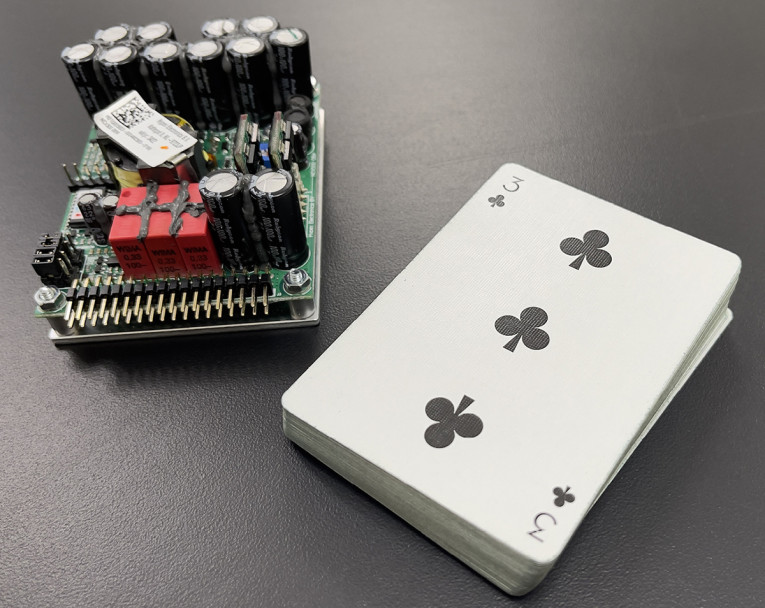
The NCx500 module is indeed about the size of a playing card (Photo 1), and the circuit board and components are bonded to a solid piece of metal plate that can be used as a heatsink at lower powers, but use of the modules at higher powers and with lower impedance loads will require external heatsinking to limit the temperature rise to safe levels. The metal plate is really meant to provide an efficient thermal interface to an external heatsink. For my testing and ultimate amplifier fabrication, I bolted the modules to a small but solid finned heatsink (Photo 2), and even with extended high power use and testing, the module was only mildly warm to the touch (perhaps 45°C). Hypex published an application note detailing thermal calculations to determine adequate heatsinking — it’s interesting that the module-to-heatsink thermal resistance can usually be neglected because of the size and efficiency of the module’s metal plate for thermal coupling. In many applications, it will be sufficient to bolt the modules to the amplifier enclosure and use that as a heatsink.

I/O to the module is accomplished through a 36-pin wire-to-board crimp connector usually used for ribbon cables. Alternately, Hypex sells an evaluation board that plugs directly into the module connector and allows rapid connection of the power supply and the signal I/O connections. For my evaluation, I used a ribbon cable so that various provided non-audio functions could be accessed and to give me flexibility once I did a more permanent installation and build.
Besides power and signal connections, that I/O connector has provisions for remote feedback in the manner of a Kelvin connection, with separate feedback leads for hot and cold. The intention is to compensate for the resistance of the connector potentially increasing the source resistance (i.e., lowering damping factor) by connecting the feedback leads to the module outputs on the far side of the 36-pin connector.
Although one might be intrigued by the idea of taking the feedback from a point further downstream (e.g., from the speaker terminals, bypassing the speaker cables), Hypex cautions that the feedback leads be limited to a few centimeters. “Using FBH/FBC to sense remotely (e.g., at the end of a speaker cable) does not work well.”
The predecessor NC500 modules did have an interesting and little-used feature: a current monitoring output (0.1V/A) derived from a 100mΩ resistor in series with the hot output lead. This could be used to detect high current conditions, which could threaten the safe operating area of the output devices, or potentially to provide a series-derived voltage for feedback that would increase the output impedance if desired, or even make the amp act as a current source rather than a voltage source. Unfortunately, this feature was not used much and was removed from the NCx500. Frank Veldman points out that the resistor and monitoring circuitry could still be added by the integrator, and if an OEM purchaser wanted that feature back, it could easily be implemented.
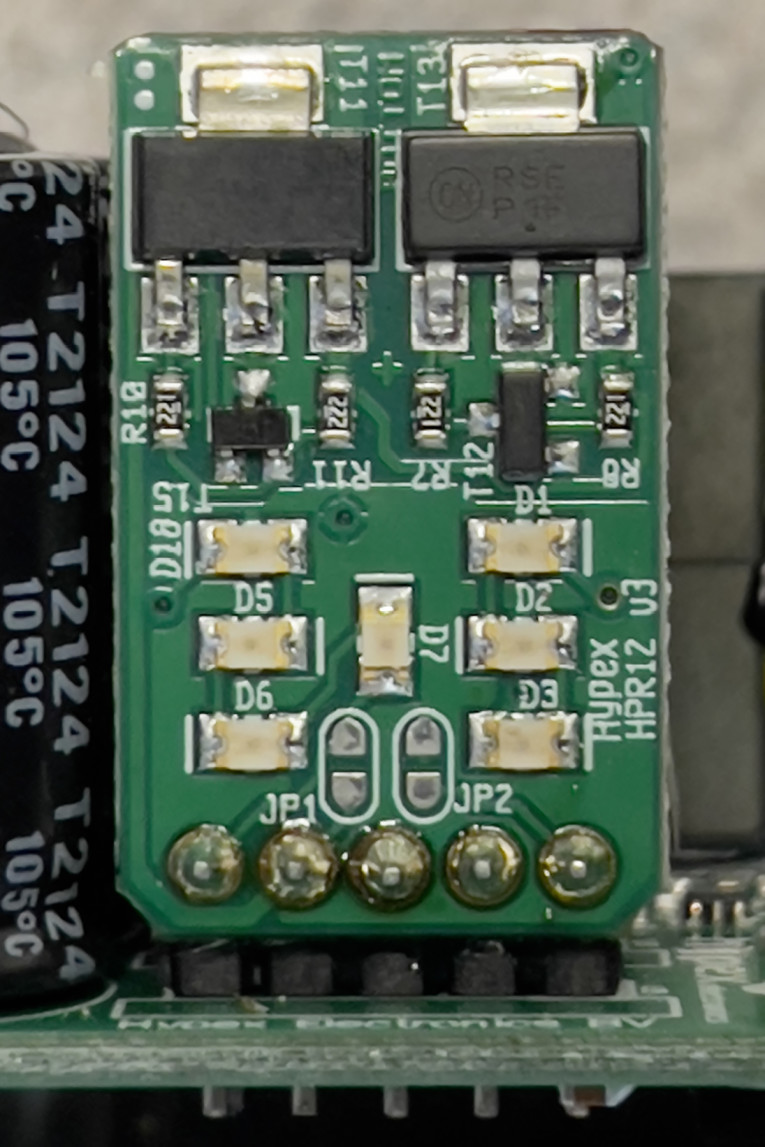
For ease of integration, the modules now have a built-in preamp stage (the word “buffer” is used a lot, but is not exactly accurate), which accepts a balanced audio input and raises the module’s rated voltage gain from 12.4dB (4.2V/V) that was standard in the NC500 to 27dB (22.4V/V), the latter mode eliminating the need for an external preamplifier. The preamp stages are powered via discrete regulator modules, which are also available as standalone regulators, the HPR-12 and the HNR-12 (+12V and -12V, respectively, Photo 3). The regulator modules use an array of red LEDs, presumably as references—I have used LEDs in the past and have found that good ones have exceptionally low noise and excellent voltage stability. One might notice that the brightly illuminated array is shaped like a capital H (Photo 4), but Hypex denies that this was deliberate branding.

Of course, an integrator might opt for using a lower gain option by resetting four jumpers (Photo 5), the gain can be reduced back to 12.4dB. To achieve full output from the modules with an 8Ω load, the drive to the module’s input needs to be 13V to 14V. So for most common system gain structures in home audio (typically 2V to 2.5V to the power amp to achieve full output), an additional gain stage must be provided. As we will see, it will be tough to achieve higher performance than the included preamp stage, but for marketing and aesthetic reasons, someone might want to use a front end made from vacuum tubes or special field-effect transistors (FETs), though the distortion and noise performance is likely to be degraded. To be fair, if the modules were capable of unity gain, I would be tempted to build a tube or hybrid differential amplifier, or use something like the ImPasse design I published in audioXpress about 15 years ago. It might not have the same stunning distortion and noise performance as the Hypex preamps, but it would be good enough to avoid any audible degradation and have a glowing glass charm.

The modules can be operated in two modes, hardware and software, selectable by either grounding or floating one of the I/O connector pins. Software mode allows addressing the module via an I2C bus using a standard 100kHz data rate. Hardware mode allows the module to act as a standard analog amplifier. There are also pins on the I/O connector to indicate amplifier failures from overload, thermal, or DC offset. The amp may be remotely placed in active or standby as well. Reading register locations, the integrator can also offer temperature and bus voltage monitoring so that additional protection circuitry can be implemented.
Speaking of voltages, the NCx500 requires symmetric bipolar high voltage for the output stage (±35V minimum, with reduced output power capability and ±85V nominal for full power), ±15V at 35mA for the low level circuitry (which is regulated down to ±12V on the NCx500 board as previously mentioned), and +15V referenced to the negative high voltage supply at 75mA to drive the gates of the output FETs. If the integrator doesn’t want to design a new supply, these voltages can all be supplied by Hypex’s SMPS1200A700 switching supply (Photo 6). This supply is good for 1200W short term, and can be connected to the NCx500 module’s control lines to allow automatic shutdown in case of excessive DC offset. Additionally, there are lines for amplifier and power supply standby and enable so that the integrator can design for avoidance of start-up and shut-down pops or other unwanted noises. The supply is mounted in a metal frame, which is significantly larger than the amp module, but it doesn’t require significant external heatsinking.

The low-level circuit supply can also be selected via jumpers to put out a regulated ±12V if the NCx500’s built-in preamp is not used so that an integrator’s external preamp can be powered.
Because the switched-mode power supply (SMPS) is set up for a two-wire mains power connection, the integrator must design the mechanicals to meet
Class II double-insulation requirements. As supplied, the power supply’s circuit board is spaced 6mm from the metal frame, so that the metal frame can still be bolted to the case to provide extra heatsinking while maintaining the minimum required insulation distance between PCB and case to meet Class II standards.
The NCx500 In Use
Because I literally mounted the amps on a breadboard, doing the setup was slightly tricky. But the balanced topology and high common-mode rejection (CMR) saved the day, and despite the crudity of the setup, the amps were dead quiet with my speakers. They were fed by the preamp output of an NAD M10 streaming amplifier through a single-ended-to-balanced connector. My loudspeakers are a biamped four-way dynamic system based on the NHT 3.3, with electronic crossover at 125Hz, so are moderately sensitive, but play very loudly when fed with enough power. Their impedance runs between 4Ω to 6Ω through most of the audible range.
The built-in nCORE amps in the M10 are usually sufficient, but every once in a while, especially with heavy metal music, I can drive them out of their comfort zone. For example, when I play Sleater-Kinney’s “Dig Me Out” at a reasonable clip for that genre, the distortion of Corin Tucker’s voice when she turns on the energy is prominent despite the built-in distortion of the source material. Switching over to the Hypex NCx500s, the fuzzy edge on her voice vanishes, leaving behind, in a weird way, clean distortion (i.e., what was actually on the recording). Ditto some big band material — Buddy Rich’s take on “Birdland” from the Class of ‘78 album played perfectly cleanly while rattling the glass windows and objects sitting on my bookcases. And yet after all that, the amps were still barely warm.
On more moderately demanding music (acoustic jazz, Americana, bluegrass, and classical), the amps sounded exactly like what the measurements indicated, that is, absolutely clean and uncolored. The low source impedance means that frequency response coloration due to interaction with the loudspeakers basically vanishes. And I should note that, at least with my loudspeakers, the amps had no audible noise — even with my ear pressed against the midrange or tweeter, I could not tell if the amp was on or off.
Although most of my testing used the NCx500 modules to power the upper part of my speakers, I did swap them for the 1ET400A Purifi amps I’ve been using to power the bass. I was unable to hear any significant difference, not surprising given the low distortion, high power delivery, and low source impedance of both amps. As a side note, the common legacy of the Purifi and Hypex modules is reflected in the I/O connector pinout, which is almost identical between the two products. The visual appearance of the boards is also remarkably similar.
On the Bench
As usual, my test setup comprises an Audio Precision APx525 audio analyzer, a Vicnic 1kHz low distortion oscillator, and various home-built high power dummy loads. Unfortunately, the metal enclosure for the amplifier had not arrived by measurement time, so these were taken with the module and the power supply on the previously mentioned breadboard with no shielding. It’s safe to assume that the already-low noise in these measurements would be reduced even further with a shielded build.
First, the basics. Gain with the preamp enabled measured 27.8dB; with the preamp disabled, the gain dropped to 12.5dB. Frequency response was flat until a small roll-off (-0.2dB) at 20kHz. Source impedance at midband was below my reliable measurement capability (<20mΩ). This could be measured with a Kelvin connection, but suffice it to say that it’s likely that in a real-world setup, the speaker cables’ resistance will vastly dominate.
With the preamp in place, the differential (+ to -) input impedance measured 94.3kΩ. With the preamp bypassed, input impedance was 2.8kV.
Next, I shorted the input to measure the output noise spectrum, which is shown in Figure 1. Typical of self-oscillating amplifiers, the principal noise component is at the switching frequency, roughly 450kHz at a few ticks above 400mV. The other notable discrete frequency component is a 2mV spike just under 100kHz, presumably originating from the switching frequency for the SMPS 1200A700 supply. In the audio range, total noise summed to under 10µV.
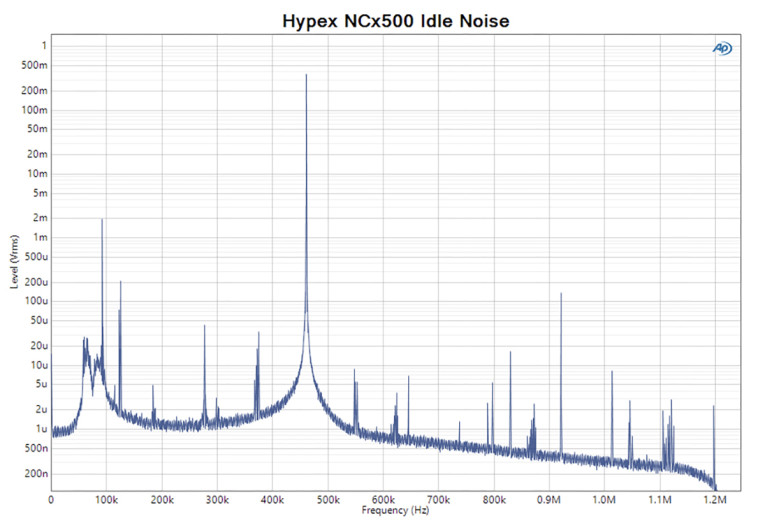
Unless otherwise noted, the following measurements were made with the preamp enabled, a 96kHz sample rate, and 256k data points.
Balanced inputs are advantageous because of CMR. CMR is very dependent on input stage impedances and topology. Figure 2 shows the CMR versus frequency of the NCx500 module, with the upper curve representing fully balanced input and the lower curve obtained by driving pins 2 and 3 of the input with identical signals (i.e., common mode). The CMR at low frequencies is extremely good at 100dB (high hum and buzz rejection), and even at high frequencies, it remains better than 50dB (i.e., over 99% of the common mode noise is rejected). The jiggle at 60Hz is due to some stray hum pickup in the measurement setup.
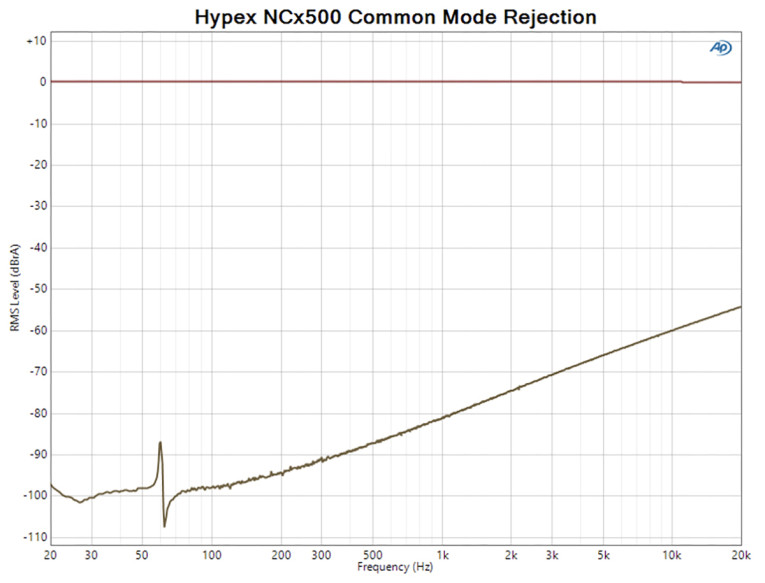
Turning to power, I first ran THD+N versus output power sweeps at 100Hz, 1kHz, and 10kHz into an 8R dummy load, the results of which are shown in Figure 3. Note the remarkably low distortion floor! The distortion starts rising at about 250W. The 10kHz distortion is a higher than at midband or bass but still only reaches 0.015% at 300W.
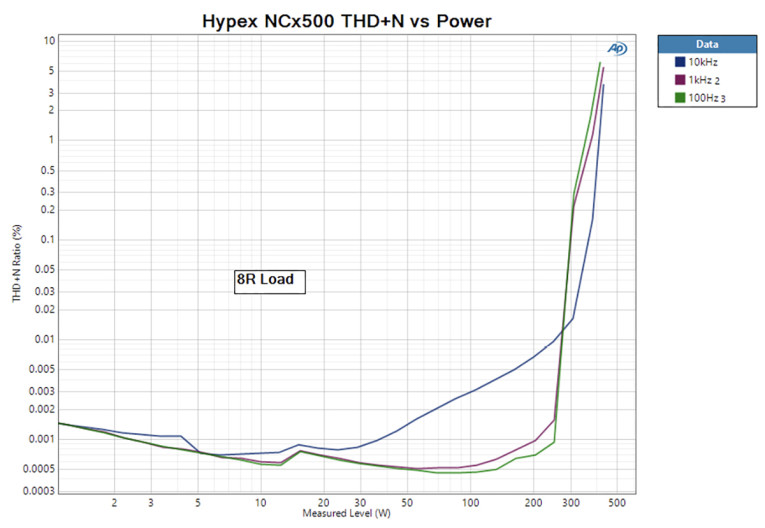
Repeating this measurement for a 4R load results in the data shown in Figure 4. In the bass, distortion reaches 1% distortion at 650W; in midband, the amp puts out 700W at the same point; and the 10kHz power at 1% distortion is about 620W. I can see why I was able to get higher clean SPL from these amps in my system! An 18kHz/19kHz IMD test at 100W didn’t faze this amp at all (Figure 5); the intermodulation product is -120dB down, which is to say a single part per million. Sidebands are slightly higher, reaching -110dB. This is remarkable performance to say the least.


Equally impressive is the dependence of distortion on frequency. Figure 6 and Figure 7 show the distortion as a function of frequency at 1W and 5W into 8R and 4R, respectively. There is some rise at higher frequencies, but even the worst case is an order of magnitude better than what the best amplifiers of 10 years ago could manage. Most of the midband distortion in the 8R results is the residual of the Audio Precision analyzer.


The harmonic distortion spectra also indicate remarkably high performance. The spectrum of a 1kHz sine wave at 1W into an 8R load is shown in Figure 8. Third harmonic is dominant at -113dB below the fundamental, which is edging pretty close to the test equipment residual. Increasing the power to 100W gives the spectrum of Figure 9, where the third harmonic has increased to -109dB, still an amazingly low level. Higher frequencies do nearly as well. Figure 10 shows 10kHz distortion at 1W into an 8R load; the third harmonic is still near test residual, but compared to the 1kHz result, second harmonic is now dominant at -109dB. All in all, these are absolutely superb measurements.
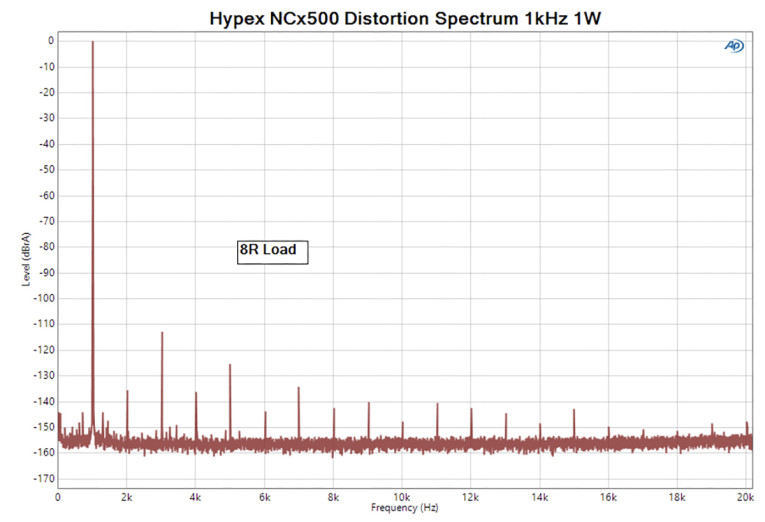


Conclusions
Although the big selling point here is the lower distortion and source impedance, in reality these two characteristics had already long ago passed the point of diminishing returns. So it’s great that the evolution of the NC series engineering is continuing, but it honestly has little or no impact on the sonic performance of these amplifiers, which remains impeccable. The real differentiator here from earlier generations, to my mind, is the built-in preamplification, which is at a performance level that integrators will have trouble equaling: These boards are the entire package, no extra circuitry needed to make an ultra-high-performance product, just box, power supply, and wiring.
The extra power and performance I get from these modules has me sifting through my bank account to see how I can buy a couple for myself. The only unrequited longings I have are for a unity gain version and current monitoring outputs. Other than that, this is as close to a perfect product as I can imagine. aX
Resources
Hypex Electronics BV “Heatsinking Requirements of Class D Amplifiers,” - https://www.hypex.nl/support/downloads/ or (direct zip file download)
Hypex Electronics BV “High Efficiency High Power SMPS”
B. Putzeys, “NCORE Technology White Paper”
B. Putzeys “The F-Word, or why there is no such thing as too much feedback,” Linear Audio Volume 1, https://linearaudio.net/sites/linearaudio.net/files/volume1bp.pdf
S. Yaniger “A Tale Of Two Class D Amplifiers,” audioXpress, July 2020.
This article was originally published in audioXpress, May 2023




